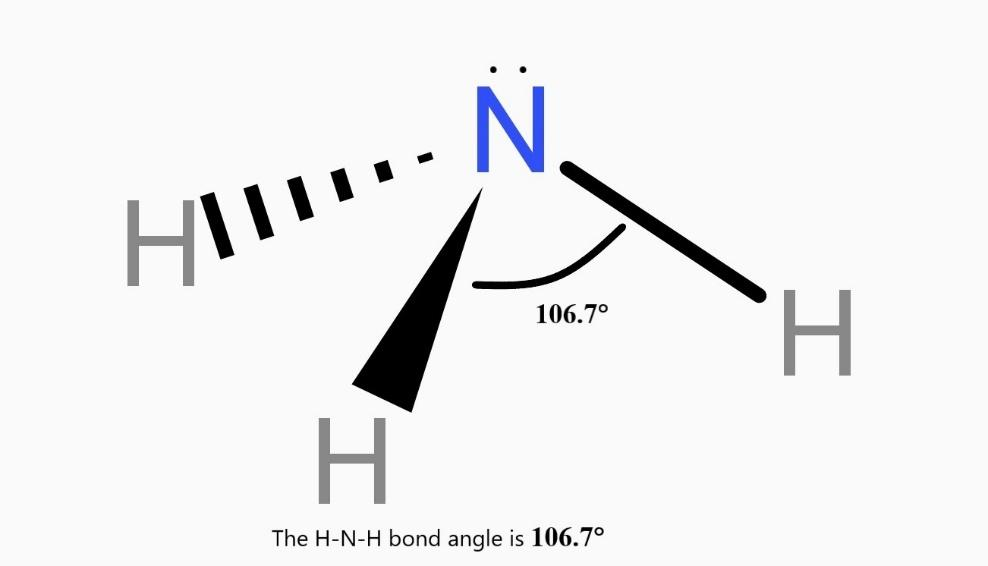
Draw the structure diagram of ammonia molecule as per the valence-shell electron pair repulsion theory.
Answer
580.8k+ views
Hint: Valence shell electron pair repulsion theory, or VSEPR theory, is a concept used in chemistry to determine the structure of single molecules from the number of pairs of electrons surrounding their central atoms. The formula of an ammonia molecule is $N{{H}_{3}}$.
Complete answer:
Valence-shell electron pair repulsion theory: The Valence Shell Electron Pair Repulsion Theory abbreviated as VSEPR theory is based on the premise that there is a repulsion between the pairs of valence electrons in all atoms, and the atoms will always tend to arrange themselves in a manner in which this electron pair repulsion is minimalized. This arrangement of the atom determines the geometry of the resulting molecule.
In a molecule two types of electron pair are there, bond pair and lone pair.
Bond pair: it is under the influence of two nuclei.
Loan pair: It is under the influence of one nucleus.
The repulsion between electron pairs follows the order, lone pair – lone pair > lone pair – bond pair > bond pair – bond pair, because different types of repulsion distortion in geometry will be observed from the standard geometry w.r.t hybridization.
Ammonia is made up of 1 atom of nitrogen and 3 atoms of hydrogen. Nitrogen has 8 electrons around it i.e. it has 4 electron pairs. These pairs are arranged tetrahedrally. Of the 4 pairs: 1 pair is a lone pair. So, the resulting shape is a trigonal pyramid.

Note: The VSEPR theory assumes that each atom in a molecule will achieve a geometry that minimizes the repulsion between electrons in the valence shell of that atom.
The structure of ammonia molecules as per the valence-shell electron pair repulsion theory is trigonal pyramid.
The H-N-H bond angle is 106.7°.
Complete answer:
Valence-shell electron pair repulsion theory: The Valence Shell Electron Pair Repulsion Theory abbreviated as VSEPR theory is based on the premise that there is a repulsion between the pairs of valence electrons in all atoms, and the atoms will always tend to arrange themselves in a manner in which this electron pair repulsion is minimalized. This arrangement of the atom determines the geometry of the resulting molecule.
In a molecule two types of electron pair are there, bond pair and lone pair.
Bond pair: it is under the influence of two nuclei.
Loan pair: It is under the influence of one nucleus.
The repulsion between electron pairs follows the order, lone pair – lone pair > lone pair – bond pair > bond pair – bond pair, because different types of repulsion distortion in geometry will be observed from the standard geometry w.r.t hybridization.
Ammonia is made up of 1 atom of nitrogen and 3 atoms of hydrogen. Nitrogen has 8 electrons around it i.e. it has 4 electron pairs. These pairs are arranged tetrahedrally. Of the 4 pairs: 1 pair is a lone pair. So, the resulting shape is a trigonal pyramid.

Note: The VSEPR theory assumes that each atom in a molecule will achieve a geometry that minimizes the repulsion between electrons in the valence shell of that atom.
The structure of ammonia molecules as per the valence-shell electron pair repulsion theory is trigonal pyramid.
The H-N-H bond angle is 106.7°.
Recently Updated Pages
Why are manures considered better than fertilizers class 11 biology CBSE

Find the coordinates of the midpoint of the line segment class 11 maths CBSE

Distinguish between static friction limiting friction class 11 physics CBSE

The Chairman of the constituent Assembly was A Jawaharlal class 11 social science CBSE

The first National Commission on Labour NCL submitted class 11 social science CBSE

Number of all subshell of n + l 7 is A 4 B 5 C 6 D class 11 chemistry CBSE

Trending doubts
Differentiate between an exothermic and an endothermic class 11 chemistry CBSE

10 examples of friction in our daily life

One Metric ton is equal to kg A 10000 B 1000 C 100 class 11 physics CBSE

Difference Between Prokaryotic Cells and Eukaryotic Cells

1 Quintal is equal to a 110 kg b 10 kg c 100kg d 1000 class 11 physics CBSE

State the laws of reflection of light




